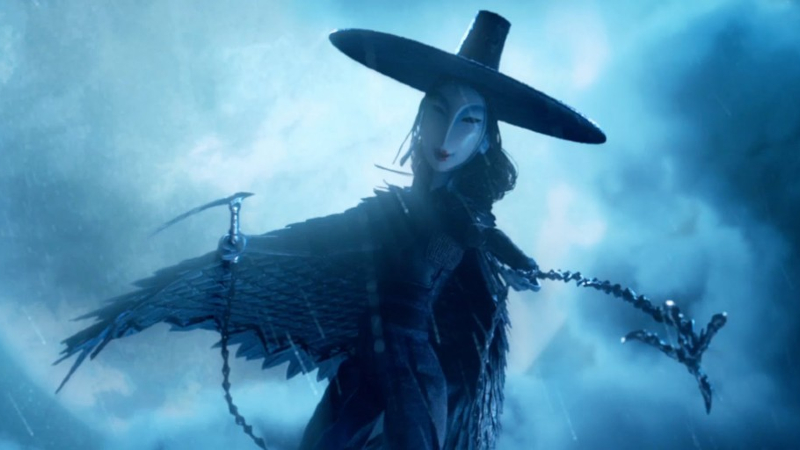Director – Travis Knight – 2016 – US – Cert. PG – 101m
*****
The following review originally appeared in Funimation UK; republished to coincide with the LAIKA: Frame x Frame exhibition which shows at BFI Southbank from Monday, 12th August to Tuesday 1st October 2024 (free to visit, but booking essential – click here) accompanied by a stop-frame animation season including all five LAIKA feature films and much, much more
A Hollywood film inspired by the Far East.
Western cinema in general and animation in particular has long held an interest in all things Oriental. Every so often, a film made in the West pays homage to one aspect or another of Eastern culture. The animated fantasy Kubo and the Two Strings is the latest entry in this curious Western sub-genre. It’s a dark fairytale about the quest of a boy named Kubo for his late father’s long-lost suit of armour to protect himself from the evil spirits of his grandfather and two aunts.
The company behind the production are US stop-frame outfit Laika who previously made Coraline, ParaNorman and The Boxtrolls. All three like Kubo are dark visions far removed from the upbeat fare that constitutes much contemporary Hollywood animation. The thought of the creative force behind such productions making a film inspired by Oriental traditions is therefore an exciting one.
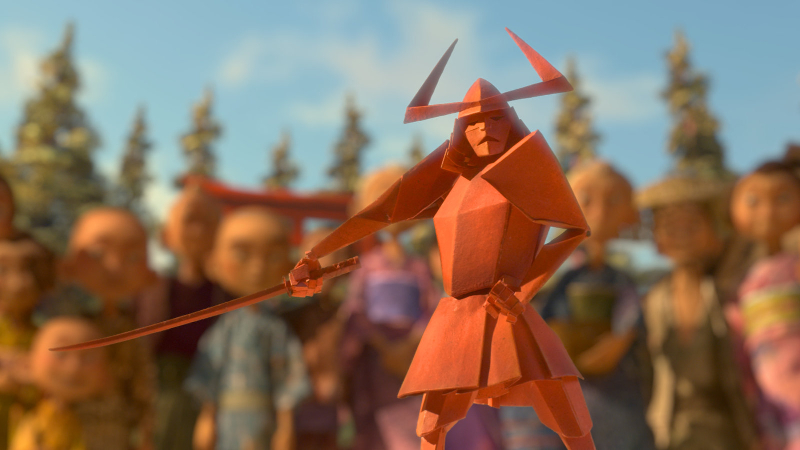
Kubo is set in an unspecified period, ancient Japan populated with samurai warriors, malevolent spirits and gargantuan monsters. Street urchin Kubo (voiced by Art Parkinson) and other performers gather at the village marketplace to display their wares and earn a crust. Kubo’s own storytelling employs animated, folded origami characters magically summoned by his shamisen, a Japanese, stringed musical instrument not dissimilar to a guitar or banjo which is played with a plectrum.
The reason Kubo needs to earn money is that his widowed mother sustained a head injury and nearly drowned while fleeing with him on a boat when he was a baby in a bravura, opening storm at sea sequence which owes much of its visual sense to works of the Edo artist Katsushika Hokusai. See for example Choshi in Shimosa Province with its boat on the curve of a giant wave and his seminal The Great Wave Off Kanagawa.
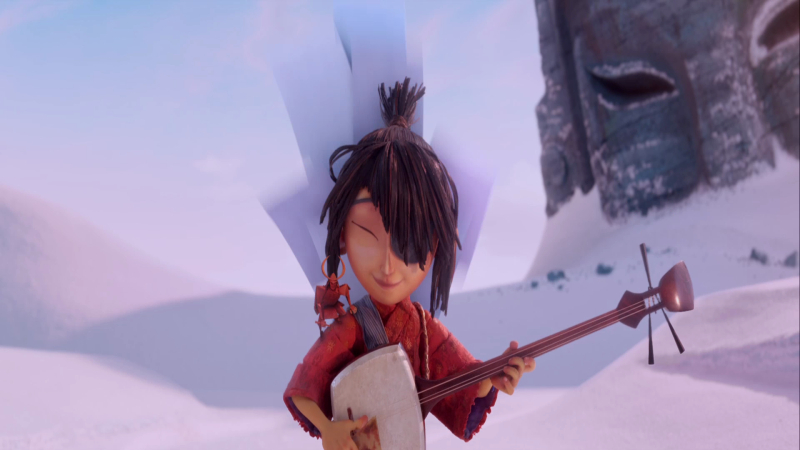
Strangely, once this opening sequence is over, the look of the film generally owes less to Hokusai and more to his contemporary the woodblock master Kiyoshi Saito with his distinctive graphic style and use of flat areas of colour.
A shock of hair over one side of Kubo’s face conceals the socket missing the eye which his grandfather the Moon King (voice: Ralph Fiennes) has stolen from him. Laika seem to have a thing about missing eyes. Coraline concerned a mysterious parallel world whose occupants had buttons for eyes. There’s a Japanese connection here too. Eye patches have a long tradition in Japanese cinema, inspired by such historic figures as Tokugowa Shogun swordsman Yagyu Jubei Mitsuyoshi and Daimyo Lord and legendary one-eyed warrior Date Masumané.
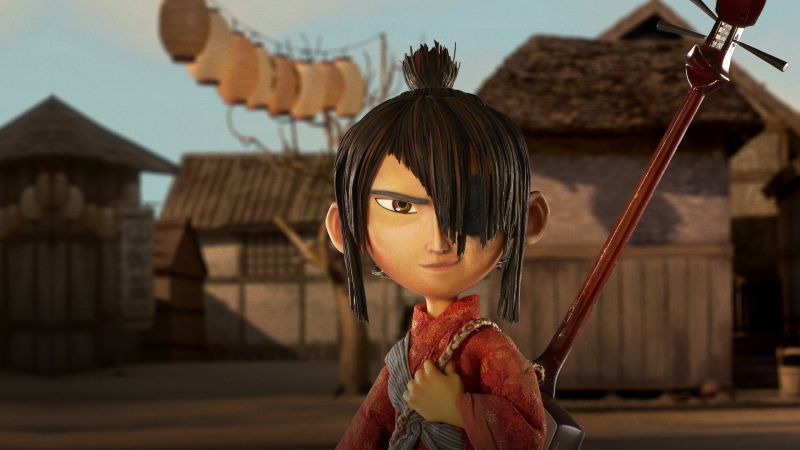
A further homage is seen in the likeness of Kubo’s absent father Hamzo, the greatest samurai warrior the world has ever known, which resembles Kurosawa regular Toshiro Mifune, an actor famous for his portrayal of samurai warriors.
Kubo has further family problems. His twin aunts (voices: Rooney Mara) are evil spirits who want to help his grandfather steal Kubo’s remaining eye. They float eerily through the air, their faces covered by Noh-inspired masks. Their appearance is often presaged by malevolent coiling and swirling smoke, recalling Hokusai’s The Dragon Of Smoke Escaping From Mount Fuji. They appear, they attack Kubo’s mother, and she is killed helping him escape.
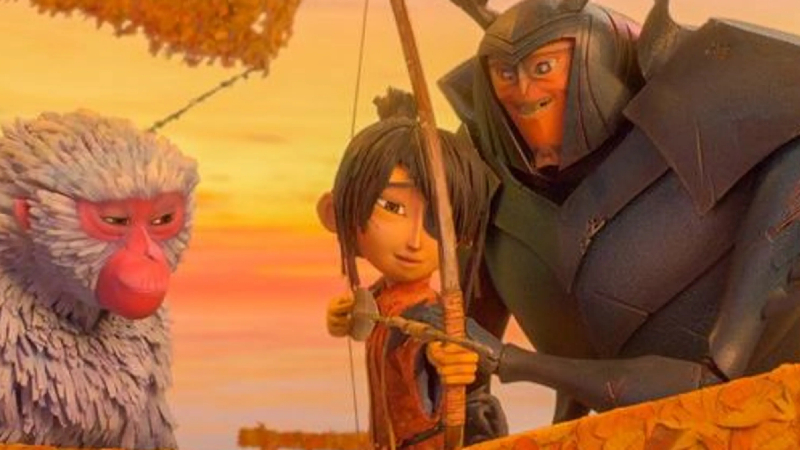
Kubo then finds himself accompanied by a monkey guide (voice: Charlize Theron) and a beetle samurai (voice: Matthew McConaughey) who between them must find his father’s Armour Impenetrable, Sword Unbreakable and Helmet Invulnerable so that Kubo can defeat the Moon King and the Sisters.
It’s hard not to equate the road movie aspect and travelling companions here with Japan’s live action Monkey TV series (1978-80), based on a Chinese novel and filmed in Chinese and Mongolian locations. The series has been widely seen around the world, thanks in no small part to an English language dub by the BBC. The eponymous Monkey accompanies the monk Tripitaka on a pilgrimage, joined by water monster Sandy and pig monster Pigsy. Kubo’s monkey and beetle companions appear cut from similar cloth.
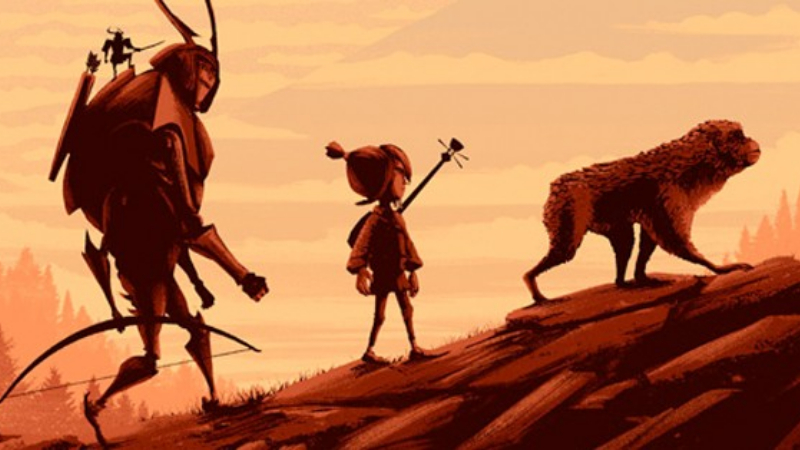
Character designer Shannon Tindle acknowledges Japan’s art and culture in his work here, He was inspired to write the original story by the relationship of his wife to her ailing mother through the prism of a fantastical, Japanese-inspired folk tale. Laika President & CEO Travis Knight was so impressed by Tindle’s pitch that he produced and directed the film himself.
Knight is an unusual film company boss in that he was also lead animator on Laika’s three prior features and producer on their last two. (He has an animator credit on Kubo as well.) In addition, he is a self-confessed fantasy and movie nerd who as a child consumed Greek and Norse myth, the Lone Wolf And Cub manga, books by Tolkien and L. Frank Baum plus films by Kurosawa, Spielberg, Miyazaki, Ridley Scott, David Lean, and George Lucas. He wanted Laika to tackle an epic fantasy, and cites Willis O’Brien’s pioneering stop-frame animation on King Kong (1933) as a major influence on the company. Knight first visited Japan when he was eight and has been smitten with the country and its culture ever since.

ParaNorman writer-director Chris Butler was one of the writers charged with fleshing out Kubo’s story into a screenplay. He had O’Brien’s protégé Ray Harryhausen in mind for the human character’s encounters with monsters, which include the giant skeleton guarding the Unbreakable Sword and the Moon King’s incarnation as a sort of cross between a centipede and a swirling Chinese dragon. Although Japan’s movie tradition of live action men in suits shot at high speed to give the impression of bulk represents a totally different production tradition to stop-frame animation, the spirit of Godzilla also hovers over Kubo’s production with Toho’s transcendent behemoth being held in high regard by members of the crew.
The resultant film demonstrates a great respect for Japanese culture on a number of levels, and also works effectively for viewers young and old as a piece of storytelling.
The LAIKA: Frame x Frame exhibition shows at BFI Southbank from Monday, 12th August to Tuesday 1st October 2024 (free to visit, but booking essential – click here) accompanied by a stop-frame animation season including all five LAIKA feature films and much, much more.
Kubo and the Two Strings was released in the UK on Friday, September 9th 2016.
The above review originally appeared in Funimation UK.
Trailer:
